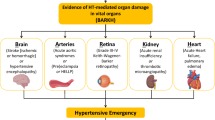Abstract
The relationship between blood pressure and orthostatic hypotension was studied in 48 elderly patients with orthostatic hypotension and 29 healthy age-matched controls. Individuals were designated as hypertensive (systolic > 160 and or diastolic > 90 mmHg) or normotensive on the basis of supine blood pressure levels. Systolic, diastolic and mean blood pressures, heart rate, stroke volume, cardiac output, cardiac index and total peripheral resistance were measured every 5 min before, during and after 10 min head-up tilt to 70°.
Eighteen orthostatic hypotension subjects and six controls were hypertensive, while 30 orthostatic hypotension subjects and 23 controls were normotensive. There were no differences between hypertensive and normotensive patients in mean age, weight, height or body surface area. Mean systolic blood pressure in orthostatic hypotension subjects was higher than in controls (148.8 ± 3.6 vs. 137.5 ± 3.34 mmHg). Mean diastolic pressure was not different (79.1 ± 2.0 vs. 79.0 ± 2.0 mmHg). There were no differences between patients with or without hypertension in the haemodynamic changes produced by head-up tilt. Heart rates in orthostatic hypotension subjects with hypertension were significantly lower throughout the study when compared with normotensive orthostatic hypotension patients. Further, the increases in heart rate on tilting were significantly smaller (8.4 ± 1.9 vs. 14.5 ± 1.8 beats/min). Control hypertensive subjects had significantly higher mean cardiac output and cardiac index compared with non-hypertensives from before and during tilt. We conclude that hypertension is not related to the development or the degree of orthostatic hypotension in the elderly. Elderly patients with orthostatic hypotension who had supine hypertension were unable to accelerate heart rate as much on tilt as normotensive patients. This may suggest cardiac impairment, failure to respond to increased sympathetic drive or a combination of these factors.
Similar content being viewed by others
References
Lipsitz LA, Jonsson PV, Marks BL, Parker JA, Royal HD, Wei JY. Reduced supine cardiac volumes and diastolic filling rates in elderly patients with chronic medical conditions. Implications for postural blood pressure homeostasis.J Am Geriat Soc 1990;38: 103–107.
Frishman WH. Epidemiology, pathophysiology, and management of isolated systolic hypertension in the elderly.Am J Med 1991;90: 14s-20s.
Lakatta EG. Determinants of cardiovascular performance: modifications due to aging.J Chron Dis 1983;36: 15–30.
Landahl S, Bengtsson C, Sigurdsson JA, Svanborg A, Svardsudd K. Age related changes in blood pressure.Hypertension 1986;8: 1044–1049.
Rowe JW. Clinical consequences of age-related impairments in vascular compliance.Am J Cardiol 1987;60: 68G-71G.
Gribbin B, Pickering TG, Sleight P, Peto R. Effect of age and high blood pressure on baroreflex sensitivity in man.Circ Res 1971;29: 424–431.
Ajayi AA, Reid JL. Renin-angiotensin modulation of sympathetic reflex function in essential hypertension and in the elderly.Int J Clin Pharmacol Res 1988;8: 327–333.
Meserli FH, Sundgaard-Riise K, Ventura HO, Dunn FG, Glade LB, Frohlich ED. Essential hypertension in the elderly: haemodynamics, intravascular volume, plasma renin activity and circulating catecholamines levels.Lancet 1983;ii: 983–986.
Lipsitz LA. Abnormalities in blood pressure homeostasis that contribute to falls in the elderly.Clin Geriat Med 1985;1: 637–648.
Imholz BP, Dambrik JH, Karemaker JM, Wieling W. Orthostatic circulatory control in the elderly evaluated by non-invasive continuous blood pressure measurement.Clin Sci 1990;79: 73–79.
MacLennan WJ, Hall MRP, Timothy JI. Postural hypotension in old age: is it a disorder of the nervous system or of blood vessels?Age & Ageing 1980;9: 25–32.
Kannel WB, Wolf PA, McGee DL, Dawber TR, McNamara P, Castelli WP. Systolic blood pressure arterial rigidity and risk of stroke: the Framingham study.J Am Med Assoc 1981;245: 1225–1229.
Heseltine D, Thomas T, Wilkinson R, James OFW, Potter JF. Potassium supplementation in the treatment of idiopathic postural hypotension.Age & Ageing 1990;19: 409–414.
Mader SL, Palmer RM, Rubenstein LZ. Effect of timing and number of baseline blood pressure determinations on postural pressure response.J Am Geriat Soc 1989;37: 444–446.
Strogatz DS, Keenan NL, Barnett EM, Wagner EH. Correlates of postural hypotension in a community sample of elderly blacks and whites.J Am Geriatr Soc 1991;39: 562–566.
Applegate WB, Davis BR, Black HR, Smith WM, Miller ST, Burlando AJ. Prevalence of postural hypotension at baseline in the systolic hypertension in the elderly program (SHEP) cohort.J Am Geriat Soc 1991;39: 1057–1064.
Aronow WS, Lee NH, Salesn FF, Etienne F. Prevalence of postural hypotension in elderly patients in a long-term health care facility.Am J Cardiol 1988;62: 336.
Caird FI, Andrews GR, Kennedy RD. Effect of posture on blood pressure in the elderly.Br Heart J 1973;35: 527–530.
Vargas E, Lye M, Faragher EB, Goddard C, Moser W, Davies I. Cardiovascular haemodynamics and the response of vasopressin, aldosterone, plasma renin activity and plasma catecholamines to head-up tilt in young and old healthy subjects.Age & Ageing 1986;15: 17–28.
Lye M, Vargas E, Faragher EB, Davies I, Goddard C. Haemodynamic and neurohumoral responses in elderly patients with postural hypotension.Eur J Clin Invest 1990;20: 90–96.
Lye M, Vargas E. An analysis of impedance cardiography in the elderly.Med Eng Technol 1981;5: 289–292.
Working Group on Hypertension in the Elderly: Statement on hypertension in the elderly.JAMA 1986;256: 70–74.
SPSS Inc.SPSS- × User's Guide, 3rd Edition. Chicago, IL: SPSS Inc., 1988.
O'Brien E, O'Malley K. ABC of blood pressure measurement technique.Br Med J 1979; ii: 982–984.
Lye M, Vargas E. The assessment of autonomic function in the elderly.Age & Ageing 1980;9: 210–214.
Gauer OH, Thron P.Handbook of Physiology, III-Section 2. Washington, DC: American Physiological Society, 1965: 2409–2439.
Author information
Authors and Affiliations
Rights and permissions
About this article
Cite this article
Vargas, E., Lye, M. Is there a relationship between supine systemic blood pressure and orthostatic hypotension in the elderly?. Clinical Autonomic Research 3, 345–349 (1993). https://doi.org/10.1007/BF01827337
Received:
Accepted:
Issue Date:
DOI: https://doi.org/10.1007/BF01827337




